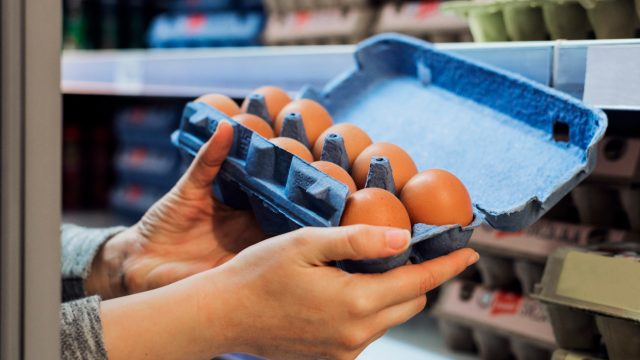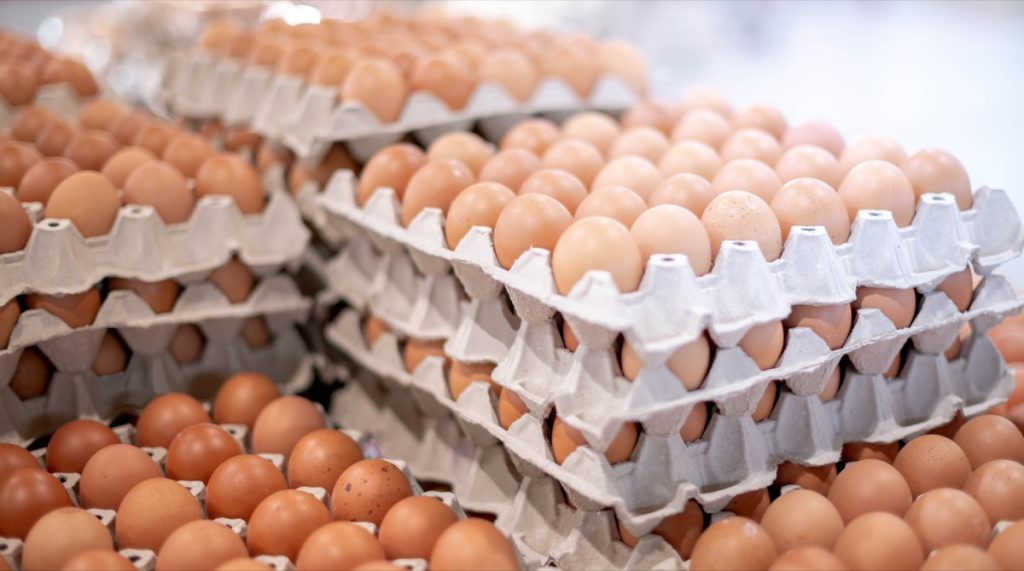Why Egg Prices Continue to Skyrocket, and When They’ll Go Down

Lately, it can feel as though a “normal” trip to the grocery store is a distant memory. After the empty shelves and drastic shortages during the COVID-19 pandemic, shoppers are now faced with stubborn inflation that seems to be driving up the cost of everyday essentials—including eggs. Higher prices on such a kitchen staple can be particularly painful since they’re not the kind of item you can easily swap out for something else. So, why do egg prices continue to skyrocket? Read on for more information on why they’ve become so expensive and when the spike will finally crack.
READ THIS NEXT: Walmart Is Under Fire for Allegedly Double-Charging Customers Again.
The price of eggs has increased much higher over the past year.

No matter what you’re buying, the prices of the products you need have likely jumped over the past year. Unfortunately, keeping your fridge and pantry stocked has been a particularly rough part of the problem. Even as the persistent rise in costs is showing signs of slowing and receding, grocery inflation has outpaced general inflation considerably, with store prices jumping 12 percent through November 2022 compared to an overall rise of 7.1 percent, according to the Bureau of Labor Statistics, per CNN.
But amid the nationwide hit on food budgets, eggs have become a particularly grim outlier as their prices have skyrocketed to even greater heights. As of January 2023, the cost of the kitchen staple is up 11 percent compared to November and nearly 60 percent compared to the same time last year, CNN reports.
As a result, many shell-shocked shoppers have been forced to seriously consider what they’re putting in their carts. “I’ve seen customers gravitate from buying organic eggs now to more conventional eggs, and specifically now, the half dozen. Prices have quadrupled in about six or seven months,” Jose Filipe, a grocery store owner in New Rochelle, New York, told CBS News.
Egg prices have jumped more than most items due to a serious issue affecting the poultry industry.

While much of the past year has been spent using inflation to blame for the rise in the cost of just about everything, egg producers are facing their own separate serious dilemma that has pushed prices higher. Since early 2022, a highly virulent version of avian influenza—also known as bird flu—has been spreading through the poultry industry, CNN reports. The outbreak has claimed the lives of more than 58 million birds and climbing, drastically reducing the production capacity of the poultry industry.
“It’s a supply disruption, ‘act of God’ type stuff,” Brian Moscogiuri, a global trade strategist at Eggs Unlimited, told CNBC. He added that the situation is “unprecedented,” saying: “It’s kind of happenstance that inflation is going on [more broadly] during the same period.”
A look at the numbers can show how severe the problem currently is. As of early December, data from the U.S. Department of Agriculture showed that there were roughly 308 million egg-laying hens at work in the U.S. “Typically, you need about one bird per person to have a close-to-balanced supply and demand with U.S. consumption,” Moscogiuri told Vox. “So we have, what, 331 million people in this country? You can see right there, there’s a huge shortfall.”
RELATED: For more up-to-date information, sign up for our daily newsletter.
The current bird flu outbreak is worse than in previous years.

This isn’t the first time avian influenza has struck the poultry industry in the U.S. An outbreak in 2015 killed 50.5 million birds, according to the Centers for Disease Control and Prevention (CDC). But this year, the agency says the strain of the virus is much more lethal, killing 90 to 100 percent of the chickens it infects in as little as two days, per CNBC. Once a farm reports an infection, federal rules also require them to cull even their healthy birds to stop the spread of the virus.
Experts say that part of the problem is that seasonal migration can factor into the spread of the virus. As wild birds traveling north or south come into contact with poultry at farms, bird flu can quickly make its way into coops—which has become more likely now that laws in certain states require birds to be able to roam freely, Vox reports.
All of this has combined to make the latest outbreak a particularly serious one. “In 2015, the virus kind of stopped once the weather got hot and the spring migration finished, and the repopulation was fully able to get going. [In 2022], it’s come back in the fall with the winter migration,” Moscogiuri told Vox.
It may take a little time for egg prices to come down, but the worst may have already passed.

Even as the poultry industry continues to deal with the effects of the ongoing bird flu outbreak, there’s a decent chance we may have already seen the worst regarding egg prices. The holiday season typically drives up demand for eggs and increases wholesale prices, Brian Earnest, lead economist for animal protein at CoBank, told CNN. But as 2023 kicks off, there could be an easing on the supply strain.
“Based on current trade values and market conditions, it appears that the market may have finally reached its peak,” Karyn Rispoli, editor of the Egg Price Current for food market data company Urner Barry, told CNN on Dec. 27.
But don’t expect the changes to be noticeable overnight. “There is usually a two-to-three-week lag between wholesale pricing and what consumers see in terms of retail pricing,” Rispoli told Vox. “That, however, assumes that retailers are passing those lower costs on. Since many retailers were selling eggs below cost when the market soared to record highs last month, they may be slower to react on the way down.”
However, any continued improvement still hinges on the future spread of the outbreak, which is unpredictable at best. “Hopefully, repopulation is continuing, and more production is on its way up, and we don’t see any more [bird flu] as we go back into this spring migration again, and the worst is behind us,” Moscogiuri told Vox. “But we really don’t know.”